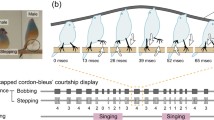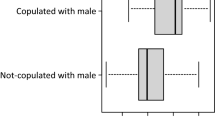Abstract
Whether female crickets choose among males based on characteristics of the courtship song is uncertain, but in many species, males not producing courtship song do not mate. In the house cricket,Acheta domesticus, we examined whether a female chose or rejected a male based on his size, latency to chirp, latency to produce courtship song, or rate of the high-frequency pulse of courtship song (“court rate”). We confirmed that females mated only with males that produced courtship song, but we found no evidence that the other factors we measured affected a female’s decision to mate. In addition, we investigated whether the outcome of male agonistic encounters affected the subsequent production of courtship song. In one experiment, we observed courtship and mating behavior when a single female was placed with a pair of males following a 10-min interaction period between the two males. Winners of male agonistic encounters had higher mating success. However, winners and losers of agonistic encounters were not different in their likelihood or latency to produce courtship song or in the number of times they were disrupted by the other male in the pair. In a second experiment, we allowed two males to interact for a 10-min period, but following this interaction period, we placed a female with each male separately and observed courtship and mating behavior. The mating success of winners and losers was not different under these circumstances, and we found no differences between winners and losers in any subsequent courtship or mating behavior examined. We conclude that winning agonistic encounters influences a male’s mating success in ways other than his production of courtship song and this effect is lost when winning and losing males are separated and each is given an opportunity to mate.
Similar content being viewed by others
References
Adamo, S. A., and Hoy, R. R. (1994). Mating behaviour of the field cricketGryllus bimaculatus and its dependence on social and environmental cues.Anim. Behav. 47: 857–868.
Alexander, R. D. (1961). Aggressiveness, territoriality, and sexual behavior in field crickets.Behavior 17: 130–223.
Burk, T. (1983). Male aggression and female choice in a field cricket (Teleogryllus oceanicus): The importance of courtship song. In Gwynne, D. T., and Morris, G. K. (eds.),Orthopteran Mating Systems: Sexual Competition in a Diverse Group of Insects, Westview Press, Boulder, CO, pp. 97–119.
Cade, W. H. (1979). The evolution of alternative male reproductive strategies in field crickets. In Blum, M. S., and Blum, N. A. (eds.),Sexual Selection and Reproductive Competition in Insects, Academic Press, New York, pp. 343–378.
Cade, W. H. (1981a). Alternative male reproductive behaviors.Fla. Entomol. 63: 30–45.
Cade, W. H. (1981b). Alternative male strategies: Genetic differences in crickets.Science 212: 563–564.
Campbell, D. J., and Shipp, E. (1979). Regulation of spatial pattern in populations of the field cricketTeleogryllus commodus (Walker).Z. Tierpsychol. 51: 260–268.
Crankshaw, O. S. (1979). Female choice in relation to calling and courtship songs ofAceta domesticus.Anim. Behav. 27: 1274–1275.
Dixon, K. A., and Cade, W. H. (1986). Some factors influencing male-male aggression in the field cricketGryllus integer (time of day, age, weight, and sexual maturity).Anim. Behav. 34: 340–346.
Doherty, J. A., and Callos, J. D. (1991). Acoustic communication in the trilling field cricket,Gryllus reubens (Orthoptera: Gryllidae).J. Insect Behav. 4: 67–82.
Doherty, J. A., and Hoy, R. R. (1985). Communication in insects. III. The auditory behavior of crickets: Some views of genetic coupling, song recognition and predator detection.Q. Rev. Biol. 60: 457–471.
Gerhardt, H. C. (1991). Female mate choice in treefrogs: Static and dynamic acoustic criteria.Anim. Behav. 42: 615–635.
Hedrick, A. V. (1986). Female preferences for male calling bout duration in a field cricket.Behav. Ecol. Sociobiol. 19: 73–77.
Hill, K. G., Loftus-Hills, J. J., and Gartside, D. F. (1972). Pre-mating isolation between the Australian field cricketsTeleogryllus commodus andT. oceanicus (Orthoptera: Gryllidae).Aust. J. Zool. 20: 153–163.
Hoy, R. R., Hahn, J., and Paul, R. C. (1977). Hybrid cricket auditory behavior: Evidence for genetic coupling in animal communication.Science 195: 82–84.
Kirkpatrick, M. (1987). Sexual selection by female choice in polygynous animals.Annu. Rev. Ecol. Syst. 18: 43–70.
Libersat, F., Murray, J. A., and Hoy, R. R. (1994). Frequency as a releaser in the courtship song of two crickets,Gryllus bimaculatus (de Geer) andTeleogryllus oceanicus: A neuroethological analysis.J. Comp. Physiol. A 174: 485–494.
Pollack, G. S. (1982). Sexual differences in cricket calling song recognition.J. Comp. Physiol. 146: 217–221.
Pollack, G. S., and Hoy, R. R. (1979). Temporal patterns as a cue for species-specific calling song recognition in crickets.Science 204: 429–432.
Pollack, G. S., and Hoy, R. R. (1981). Phonotaxis to individual rhythmic components of a complex cricket calling song.J. Comp. Physiol. 144: 367–373.
Searcy, W. A., and Andersson, M. (1986). Sexual selection and the evolution of song.Annu. Rev. Ecol. System. 17: 507–533.
Siegel, S. (1956).Nonparametric Statistics for the Behavioral Sciences, McGraw-Hill, New York.
Simmons, L. W. (1986a). Female choice in the field cricketGryllus bimaculatus (DeGeer).Anim. Behav. 34: 1463–1470.
Simmons, L. W. (1986b). Inter-male competition and mating success in the field cricket,Gryllus bimaculatus (DeGeer).Anim. Behav. 34: 567–579.
Simmons, L. W. (1988a). The calling song of the field cricket,Gryllus bimaculatus (De Geer): Constraints on transmission and its role in intermale competition and female choice.Anim. Behav. 36: 380–394.
Simmons, L. W. (1988b). Male size, mating potential and lifetime reproductive success in the field cricket,Gryllus bimaculatus (De Geer).Anim. Behav. 36: 372–379.
Simmons, L. W., and Zuk, M. (1992). Variability in call structure and pairing success of male field crickets,Gryllus bimaculatus: The effects of age, size and parasite load.Anim. Behav. 44: 1145–1152.
Stevens, J. (1992).Applied Multivariate Statistics for the Social Sciences, Lawrence Erlbaum, Hillsdale, NJ.
Stout, J. F., Deltann, C. H., and Mcghee, R. W. (1983). Attactiveness of the maleAcheta domesticus calling song to females.J. Comp. Physiol. 153: 509–521.
Ulagaraj, S. M., and Walker, T. J. (1973). Phonotaxis of crickets in flight: Attraction of male and female crickets to male calling songs.Science 182: 1278–1279.
Zuk, M. (1988). Parasite load, body size, and age of wild-caught male field crickets (Orthoptera: Gryllidae): Effects on sexual selection.Evolution 42: 969–976.
Author information
Authors and Affiliations
Rights and permissions
About this article
Cite this article
Nelson, C.M., Nolen, T.G. Courtship song, male agonistic encounters, and female mate choice in the house cricket,Acheta domesticus (Orthoptera: Gryllidae). J Insect Behav 10, 557–570 (1997). https://doi.org/10.1007/BF02765377
Issue Date:
DOI: https://doi.org/10.1007/BF02765377




